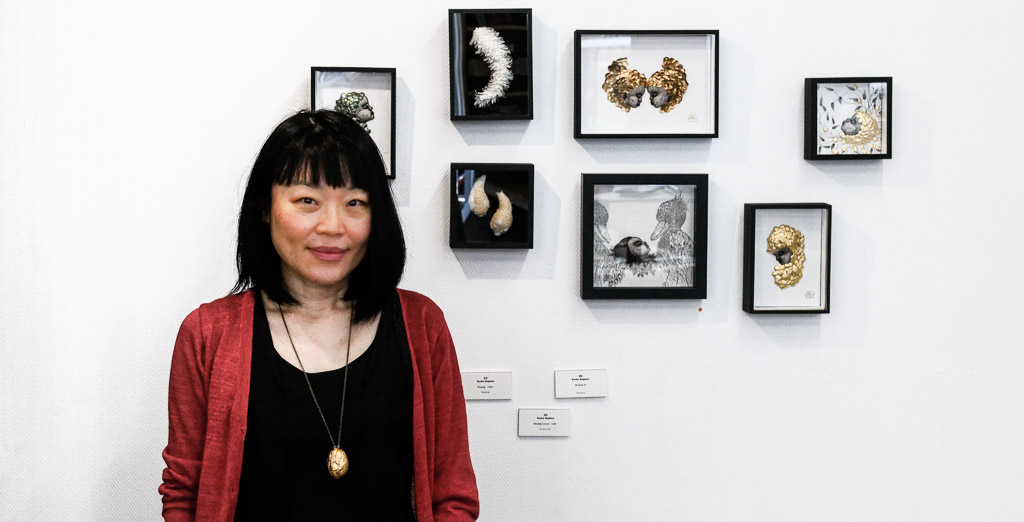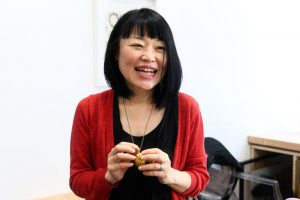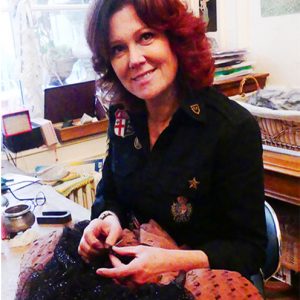
She’s got these lace-up hands and gestures to damned Vermeer; then almond eyes of infinite sweetness, and an enigmatic smile, almost supernatural. It certainly comes from elsewhere! Eternally young, Kyoko Sugiura is an art embroiderer and designer, of Japanese origin, who creates endlessly in her Parisian workshop pieces embroidered with great finesse. Mastery of its ancestral art, reappropriation with poetry, so that everything, nature and its seasons, animals, emotions, recount a unique moment with delicate embroidery and full of feelings. It is also a privilege to meet her because we discover a luminous artist as the lamp of night and infinitely accurate in her creations, her words and her nobility of soul.
Her Japanese education
“I was born in Chiba, a city on the outskirts of Tokyo, to a family that had no special connection with art.” It’s her mother who’s going to push her in that direction. She was incredibly good at knitting, sewing, embroidery, cooking, which she had learned in school like any Japanese girl who was preparing to become a model woman for her family “and she did everything for me”. She used to sew her clothes, and even though at that time Kyoko wanted to be dressed like everyone else, and especially to buy her clothes, today these memories are very valuable to her. “It was really wonderful. She made me pretty dresses, even school bags and bed covers. Everything was homemade and intended to please me, and to feel unique in the world.” Kyoko will learn these disciplines at around the age of 11. The little girl lived near a large park that she crossed every day to go to school and she particularly liked this living nature and the holidays spent on the farm of her maternal grandparents, who worked in rice fields, “in the countryside, with cows grazing near the river”.

The thread of embroidery

Her mother was very demanding in her mode of education; For example, there were plenty of little rules to follow every day, such as at the time of the traditional Japanese meal, put the miso soup on the right and the rice bowl on the left. “I learned the rigor and patience that helped me assimilate embroidery techniques later.” Kyoko quickly got her hand to knit in school and she excelled in the disciplines of manual art. She also works pieces at home with her mom. But she will continue her studies normally and learn chemistry to move into agriculture. At the same time, she did small jobs, notably working in theaters, which allowed her to access culture.
After finishing her university degree, Kyoko Sugiura will take up an office work, but will continue to learn embroidery techniques in evening courses offered by a publishing house. “I couldn’t sleep at night because this activity galvanized me so much, and I brought my work and my works together day and night.” She will then start practicing her art. For each creation, she used to choose with care her supplies (fabrics, dimensions, yarns and other accessories) to draw, embroider, assemble, make and create a beautiful object through the fabric and yarn. Hours of work for a sublime result, pure beauty, elegant and refined. “My first designs were cushions, bags, frames, and at the entrance to my parents’ house, there’s always my painting of flowers with lots of light floral variations, and filled with lots of intense colors.”
First achievements
Kyoko married at the age of 25 and enrolled in a fashion school, where for 3 years she was going to improve in stitch embroidery and sewing techniques, to unleash her creativity on any type of fabric. She also taught at this school and started thinking about the self-employment project, with personal art-works. At this time, she also learned the secrets of the “Nihon Shishu”, the traditional Japanese embroidery, which is used in particular to make paintings, kimonos, obis and which conveys the essential values of Japan. An embroidery with silk threads and hand that allows to offer the traditional lightness of fine silk.
It is here that she will make her first trip to France. “We visited the South and then Paris and there I found a big fabric store that changed my life.” Thick fabrics, unique in their kind and designed for interior decoration. She will buy several models and make embroidered bags for herself, which will be a great success. Very soon, she had a proposal to exhibit her creations in an art gallery in Ginza. His career is on the way. Kyoko opens a shop in Tokyo, continuing to source fabrics from Paris where she will come once a year.
She then embroidered on many different materials, with sequins, beads, cotton yarns or wool to nourish both a collection, and for some models custom made for her customers. In order to expand its range, Kyoko Sugiura will offer classic bags for the day and more sophisticated embroidered bags for special occasions. And she will also give embroidery and sewing classes during the day in her workshop.

Create and transmit

In 2009, both spouses decided to take two sabbatical years, and came to settle in Paris. Kyoko enrolled in a private embroidery school in Sartrouville to learn the technique of Lunéville hooks which are used for art embroidery and fashion haute-couture, for embroidering in Beauvais stitch, chainnet, or for laying beads and sequins. It is here that she will begin to practice in haute couture workshops, first as a trainee, then as a service provider, twice a year, to prepare the most beautiful collections of Parisian fashion shows. “In France, what I learned was more the artistic spirit, and the luxury that inspires me. The attention to ornament, infinite details, subtle materials and an overflowing creativity.”
Today, she continues her work with soon textile sculptures where she will mix several techniques, such as stitching, knitting, drawing, gilding, etc. and her personal creations with her international clientele and to prepare exhibitions. She also teaches at a fashion school in the Paris region. “It is so important to constantly evolve and to get out of your comfort zone. I now like to return to Tokyo with a different look. Moreover, in my island country, a foreign country is said to be ‘beyond the sea’. You have to cross the sea to get out of it, then come back.”
Is Kyoko Sugiura related to Princess Kaguya, Japan’s famous old tale? Born in a bamboo, she comes from the Moon and she goes back to it all her life. Like her, she takes us there constantly when her lace-making hands embroider without stopping to restore us a dreamlike beauty, almost from another planet. But Kyoko Sugiura is also a free woman-artist who carries in her a precious sensitivity, which allows her to capture everything that touches her and express her not in restraint, as in Japanese culture, but in a creative language that is very much her own, entirely left to her art and everything that goes through her…
Interview held by Carine Mouradian on 21 September 2019
Link to the website of Kyoko Sugiura Créations

Photo Gallery of Kyoko Sugiura
Authenticity according to Kyoko Sugiura, the creator of inspirational and contemplative embroideries

“ From my upbringing, I kept a way of thinking about Japanese life, where you always have to think about others first. Another difference with European culture is that in Japan, you don’t say what you think right away. We will pay close attention to the words and the way in which they were said, in order to seek consensus, and above all not to offend the other, in order to preserve the relationship. Here in France, we are used to a certain frankness in verbal exchanges and I found it so different and so much simpler in the end. I can see what others are thinking, whereas in Japan one must often guess. Of course, this can lead to conflict. So Japan and France have two extremes, and the association creates a real balance, where you can finally be yourself while sparing others. So what’s important to be authentic is the middle ground. To be true, to be honest and to have the respect of all beings. So we move forward in life, always feeling connected to our heart, and with an open and curious mind, like a child.
A real embroiderer does not see time pass; she embroidered day and night. This has naturally imposed itself on me and has even become an imperative necessity, a vital impetus. It is the embroidery gesture that guides me; it is this gesture that i love above all. We’re not aware of the effort anymore. Then, depending on the inspiration of the moment, something goes through us and we are tools in the service of this motion. As long as the work is not finished, we cannot rest… It is like a breath. I don’t know how I came to represent animals for example. I don’t calculate. It touched me, fed me and there was an urgency at some point to express it. Moreover, my paintings, my jewels, once made, no longer belong to me. They don’t need me anymore. So I can’t speak for them and tell their mission. It’s a mystery, like their design. The reception of an artistic expression art is really a personal thing and even if you like my paintings, I can’t say exactly why I did it this way. The creation came out of me and I realized it. So I feel like I’m serving without understanding the ultimate goal, and if in addition, it touches people, moves something within them, gives them a light, a direction, an answer… it’s just bonus.
Besides, I don’t have any actual schematic or creative guidelines to give. It’s always different. I think in my head, I have a lot of ideas, images, smells, all at once, and at some point, one of them really expresses itself and comes into the light. So there’s a maturation that’s happening almost without me knowing. And sometimes I can have an idea and I’ll figure out how to use matter to make it happen. Technique is therefore important, but it is only a means for creation, this absolute act that takes us out of ourselves. This is why we must continue to nourish the interior by choosing everything that is good for us and so that, each time, creation is like a renaissance. This indoor garden therefore needs to be maintained. Even if I’m very busy, I’d take the time to visit the park, or a museum for that. We’re a bridge between inside and outside. So my advice is to have lots of ideas, lots of inspirations, to master lots of techniques and to mix it all up to create.
I draw my inspiration from flowers and nature, but also from my reading, especially historical novels. Many things affect me, the words, the vocabulary, and also the lives of important characters in the history of Japan or France, who have had extraordinary qualities and are arousing my admiration. So there’s a side to dreams and escapism in other times and in other cultures, which I’m bringing back into the world today. Maybe he’s going too fast! Today, everything is instantaneous, and with the Internet, images are available to us without having the opportunity to exercise our imagination. Words allow it. I can imagine the places, put beauty in them, pay attention. It’s this journey that’s interesting, a world of exploration and awakening every time.
In Tokyo, you lived in a very urban megalopolis, with artificial lights, but in Paris, there is always a park, a piece of nature at the corner of the street to recharge your batteries and find inspiration. And that’s the real luxury for me. Take the time to observe, to have this contact with nature and to taste an inner peace, with ineffable joy. Two days ago, I also lived a special moment in the middle of the night. Having trouble sleeping, I got up and in the dark I gazed at the Full Moon from my window. It was in these moments that I imagined the paintings of the sleepers (smile). In the end, the real luxury is to take the time, even to do nothing, but above all to be in the present moment, This philosophy has a name: ‘Ichigo ichie’. Because the present moment is unique, even more so in an encounter with someone. You really have to live it with a lot of respect, savor it, because what’s happening now will never happen again.”
Interview held by Carine Mouradian on 21 September 2019
Link to the website of Kyoko Sugiura Créations






